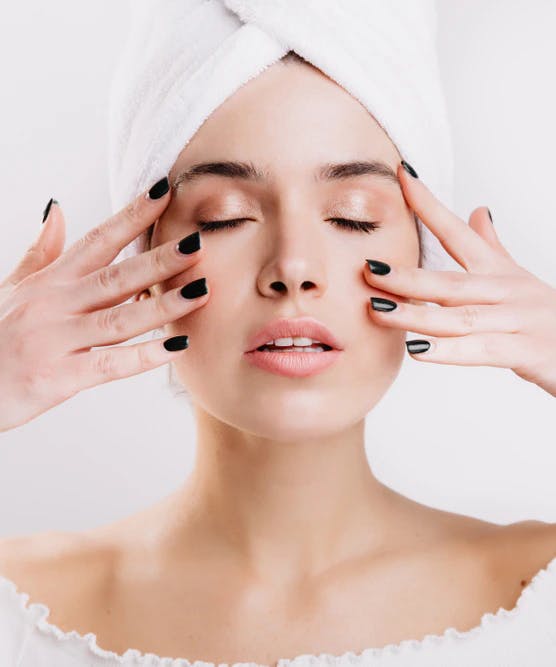Why Are We Spending So Much Money On Makeup Designed To Make It Look Like We're Not Wearing Any?
Centuries after makeup was used as a tool by the elite to signify wealth and status, it’s become perhaps the most popular way for us to express ourselves. Makeup can be a major confidence booster and is sometimes the key to nailing a certain outfit and putting a spring in our step.

Apart from use in the day-to-day, makeup, specifically the brands we choose to buy and how much — or how little — we wear, sends a larger message about the people we are or at least who we choose to present ourselves as. It’s a little unclear as to when exactly the “fresh-faced” look emerged, but now that it dominates the market and the beauty industry as a whole, we should actively analyze how this trend and the messages it sends affects us as women and as consumers.
It’s All in the Marketing
As a little girl, I remember regularly opening up my mom’s copy of makeup artist Kevyn Aucoin’s part-autobiography, part-makeup how-to guide Making Faces, which continues to be used by legends in the industry today. This book, published in 1997, is filled to the brim with the staples of most ‘90s looks: matte finishes, overlined lips, tons of blush, heavy eyeliner, and smokey eyes. Buried within the pages (aside from valuable critiques and helpful tips) are a marked distinction and a clear departure from the more colorful, provocative looks of the ‘80s to more fresh-faced, minimalistic aesthetics. This is exemplified in the popular looks of the most heavily utilized models of the time, like Cindy Crawford and the “anti-supermodel” herself, Kate Moss.
Now that we’re well into the new millennia, the fresh-faced look, or interchangeably the “no-makeup makeup” look, dominates the industry as arguably the most popular aesthetic of our new decade. Now that there’s such an emphasis on seemingly using less makeup for minimalist tones, cleaner lines and dewier, fresher looks, you’d think that we’d see a decline in makeup sales as consumers focus more on the fundamentals of skincare and forego heavier staples like foundation, contouring, highlighter, and the like. But that’s not the case at all.
Products that work well for us and help us feel like our best selves are often worth the investment and the heftier price tag.
The beauty world has exploded into a billion-dollar industry, and the no-makeup makeup trend has thrived under the promotion of higher-end brands like Glossier, Milk Makeup, Clinique, and many more. As many consumers know, especially in the beauty world, products that work well for us and help us feel like our best selves are often worth the investment and the heftier price tag. Many of these brands claim to be affordable, but who can afford their products remains to be seen. The bottom line is, why are we paying more money to look like we’re not wearing anything at all?
Why We Continue To Fall for It
Although most of us are aware of the following, it’s important to be reminded: advertisers are in the business of selling us the people we want to be, not the people we actually are. With makeup especially, it’s easy to get caught up in the narrative that buying this or that product — regardless of the price tag or how ethically it’s sourced, for example — will make us the person we want to be. But as we’re aware, when any product wears off, we’re still left feeling empty.
With makeup especially, it’s easy to get caught up in the narrative that buying this or that product will make us the person we want to be.
This has never been more apparent than with this particular trend. Now more than ever, we’re repeatedly told and emphasized to be ourselves, to bare our faces to the world with all its flaws, to forgo waking up early to put on a full face of makeup. And then, we’re targeted with a $40 finishing powder or “your skin but better” foundation that’s so sheer we might as well have not put anything on.
This trend, and its marketing in particular, have conditioned us into believing a specific conclusion that isn’t necessarily true: women who wear more noticeable makeup and are fully “made up” are perceived as difficult or high-maintenance, while women who opt out of wearing makeup (or at least looking like they don’t) are more laid-back and easygoing.
Aside from benefiting from these cliches, brands are playing into our deepest insecurities with these specific products, and it’s evident that it’s working. We’re letting them succeed because we know what our skin looks like completely bare, and showing off our natural, naked selves should be enough. But still we’re encouraged to put on products and pass it off as the real thing, as though we’re naturally “flawless.”
This trend and its marketing have conditioned us into believing that women who opt out of wearing makeup (or at least looking like they don’t) are more laid-back.
The poet Charles Baudelaire said that the devil’s greatest trick was convincing the world he didn’t exist. If that’s the case, then the most successful ploy ever pulled off by the beauty industry has been getting us to buy even more products just to look as though we didn’t buy any.
Closing Thoughts
While designer brands and luxury labels continue to see success by taking advantage of this movement, it’s now easier than ever to afford good quality makeup without the markup. Although it sounds almost stupid, we need to realize that it’s okay to look like we’re actually wearing makeup if and when we choose to use it.
As for the “no makeup” makeup movement, perhaps the best way of combating this twisted contradiction is a post-movement of sorts...one where we assert ourselves as part of the fresh-faced crowd by not wearing any makeup...literally.